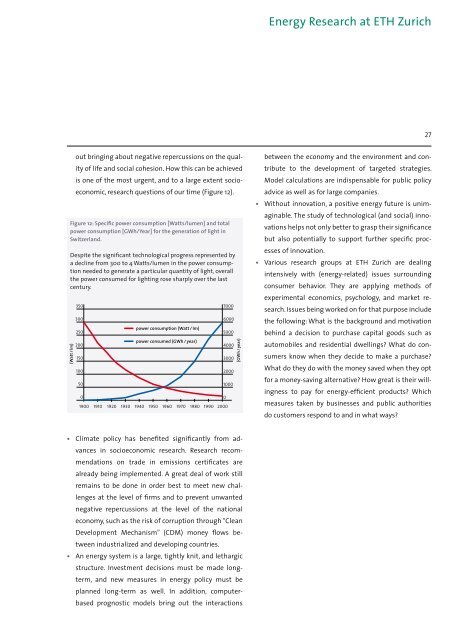Energy Strategy for ETH Zurich
Energy Strategy for ETH Zurich
Energy Strategy for ETH Zurich
Create successful ePaper yourself
Turn your PDF publications into a flip-book with our unique Google optimized e-Paper software.
•<br />
•<br />
out bringing about negative repercussions on the quality<br />
of life and social cohesion. How this can be achieved<br />
is one of the most urgent, and to a large extent socio-<br />
economic, research questions of our time (Figure 12).<br />
Figure 12: Specific power consumption [Watts/lumen] and total<br />
power consumption [GWh/Year] <strong>for</strong> the generation of light in<br />
Switzerland.<br />
Despite the significant technological progress represented by<br />
a decline from 300 to 4 Watts/lumen in the power consumption<br />
needed to generate a particular quantity of light, overall<br />
the power consumed <strong>for</strong> lighting rose sharply over the last<br />
century.<br />
(Watt / lm)<br />
350<br />
300<br />
250<br />
200<br />
150<br />
100<br />
50<br />
power consumption (Watt / lm)<br />
power consumed (GWh / year)<br />
0<br />
0<br />
1900 1910 1920 1930 1940 1950 1960 1970 1980 1990 2000<br />
7000<br />
6000<br />
5000<br />
4000<br />
3000<br />
2000<br />
1000<br />
Climate policy has benefited significantly from ad-<br />
vances in socioeconomic research. Research recommendations<br />
on trade in emissions certificates are<br />
already being implemented. A great deal of work still<br />
remains to be done in order best to meet new challenges<br />
at the level of firms and to prevent unwanted<br />
negative repercussions at the level of the national<br />
economy, such as the risk of corruption through “Clean<br />
Development Mechanism” (CDM) money flows between<br />
industrialized and developing countries.<br />
An energy system is a large, tightly knit, and lethargic<br />
structure. Investment decisions must be made longterm,<br />
and new measures in energy policy must be<br />
planned long-term as well. In addition, computerbased<br />
prognostic models bring out the interactions<br />
(GWh / year)<br />
•<br />
•<br />
<strong>Energy</strong> Research at <strong>ETH</strong> <strong>Zurich</strong><br />
27<br />
between the economy and the environment and contribute<br />
to the development of targeted strategies.<br />
Model calculations are indispensable <strong>for</strong> public policy<br />
advice as well as <strong>for</strong> large companies.<br />
Without innovation, a positive energy future is unimaginable.<br />
The study of technological (and social) innovations<br />
helps not only better to grasp their significance<br />
but also potentially to support further specific processes<br />
of innovation.<br />
Various research groups at <strong>ETH</strong> <strong>Zurich</strong> are dealing<br />
intensively with (energy-related) issues surrounding<br />
consumer behavior. They are applying methods of<br />
experimental economics, psychology, and market research.<br />
Issues being worked on <strong>for</strong> that purpose include<br />
the following: What is the background and motivation<br />
behind a decision to purchase capital goods such as<br />
automobiles and residential dwellings? What do consumers<br />
know when they decide to make a purchase?<br />
What do they do with the money saved when they opt<br />
<strong>for</strong> a money-saving alternative? How great is their willingness<br />
to pay <strong>for</strong> energy-efficient products? Which<br />
measures taken by businesses and public authorities<br />
do customers respond to and in what ways?
















